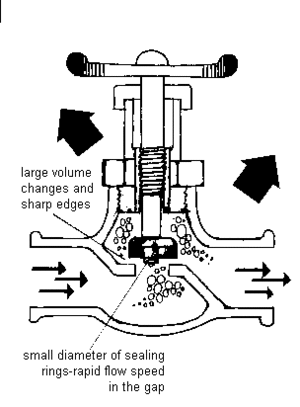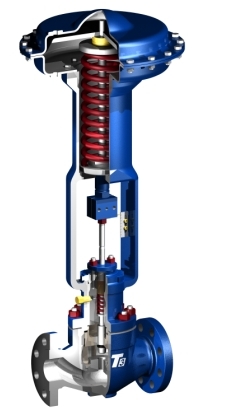Difference between revisions of "Control Valves"
(Created page with "Category:Valves{{Knoppen}} <noinclude><!------------------------------------------------ * READ THIS FIRST * Only edit this page if you can improve the content. * Improper u...") |
|||
| (One intermediate revision by the same user not shown) | |||
| Line 1: | Line 1: | ||
[[Category:Valves]]{{Knoppen}} | [[Category:Valves]]{{Knoppen}} | ||
[[File:Control valve.gif|thumb|right|Control Valves]] | |||
* | [[File:Control Valve1.jpg|thumb|right|Control Valves]] | ||
* | '''Control Valves''' are [[Valves]] used to control conditions such as flow, pressure, temperature, and liquid level by fully or partially opening or closing in response to signals received from controllers that compare a setpoint to a process variable whose value is provided by [[Sensors]] that monitor changes in such conditions. | ||
* | |||
The opening or closing of control valves is usually done automatically by [[Electrical Actuators]], [[Hydraulic Actuators]]or [[Pneumatic Actuators]]. [[Positioners]] are used to control the opening or closing of the actuator based on electric, or pneumatic signals. These control signals, traditionally based on 3-15psi (0.2-1.0bar), more common now are 4-20mA signals for industry, 0-10V for HVAC systems, and the introduction of Smart systems, HART, Fieldbus Foundation, and Profibus being the more common protocols. | |||
* | |||
* ------------ | A control valve consists of three main parts in which each part exist in several types and designs: | ||
* Valve's actuator | |||
* Valve's positioner | |||
* Valve's body | |||
==Types of control valve bodies== | |||
The most common and versatile types of control valves are sliding-stem globe and [[Angle Valves]]. Their popularity derives from rugged construction and the many options available that make them suitable for a variety of process applications, including severe service.Control valve bodies may be categorized as below: | |||
* Angle valves | |||
:* Cage-style valve bodies | |||
:* DiskStack style valve bodies | |||
* Angle seat piston valves | |||
* [[Globe Valves]] | |||
:* Single-port valve bodies | |||
:* Balanced-plug cage-style valve bodies | |||
:* High capacity, cage-guided valve bodies | |||
:* Port-guided single-port valve bodies | |||
:* Double-ported valve bodies | |||
:* Three-way valve bodies | |||
* [[Diaphragm Valves]] | |||
* [[Rotary Valves]] | |||
:* Butterfly valve bodies | |||
:* V-notch ball control valve bodies | |||
:* Eccentric-disk control valve bodies | |||
:* Eccentric-plug control valve bodies | |||
* Sliding cylinder valves | |||
:* Directional control valves | |||
:* Pool valve | |||
:* Piston valves | |||
* Air operated valves | |||
:* Air operated valve | |||
:* Relay valve | |||
:* Air operated pinch valve | |||
==Sources== | |||
[http://en.wikipedia.org/wiki/Control_valves Wikipedia Control valves] | |||
Latest revision as of 21:50, 11 January 2013
Control Valves are Valves used to control conditions such as flow, pressure, temperature, and liquid level by fully or partially opening or closing in response to signals received from controllers that compare a setpoint to a process variable whose value is provided by Sensors that monitor changes in such conditions.
The opening or closing of control valves is usually done automatically by Electrical Actuators, Hydraulic Actuatorsor Pneumatic Actuators. Positioners are used to control the opening or closing of the actuator based on electric, or pneumatic signals. These control signals, traditionally based on 3-15psi (0.2-1.0bar), more common now are 4-20mA signals for industry, 0-10V for HVAC systems, and the introduction of Smart systems, HART, Fieldbus Foundation, and Profibus being the more common protocols.
A control valve consists of three main parts in which each part exist in several types and designs:
- Valve's actuator
- Valve's positioner
- Valve's body
Types of control valve bodies
The most common and versatile types of control valves are sliding-stem globe and Angle Valves. Their popularity derives from rugged construction and the many options available that make them suitable for a variety of process applications, including severe service.Control valve bodies may be categorized as below:
- Angle valves
- Cage-style valve bodies
- DiskStack style valve bodies
- Angle seat piston valves
- Globe Valves
- Single-port valve bodies
- Balanced-plug cage-style valve bodies
- High capacity, cage-guided valve bodies
- Port-guided single-port valve bodies
- Double-ported valve bodies
- Three-way valve bodies
- Butterfly valve bodies
- V-notch ball control valve bodies
- Eccentric-disk control valve bodies
- Eccentric-plug control valve bodies
- Sliding cylinder valves
- Directional control valves
- Pool valve
- Piston valves
- Air operated valves
- Air operated valve
- Relay valve
- Air operated pinch valve

